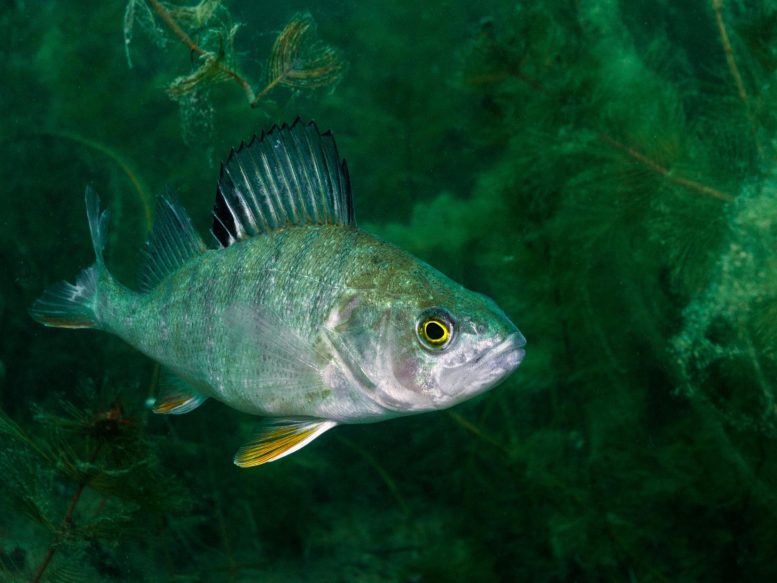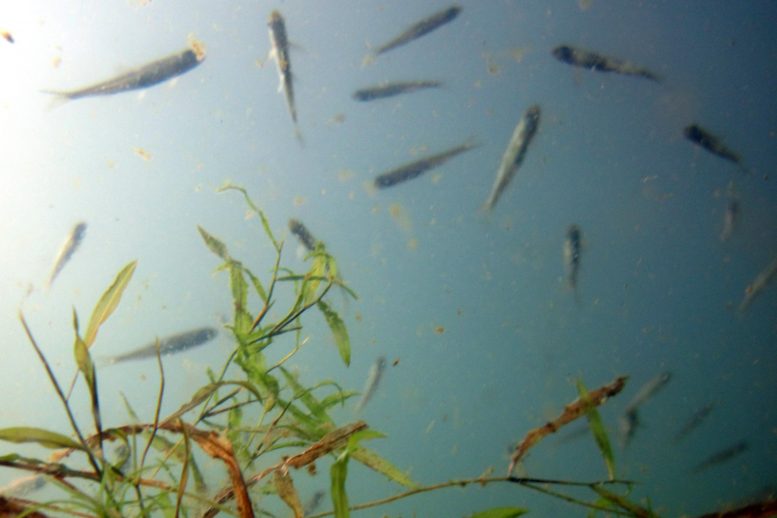
Oxygen levels in the world’s temperate freshwater lakes are rapidly declining.
Oxygen levels in the world’s temperate freshwater lakes are declining rapidly — faster than in the oceans — a trend driven largely by climate change that threatens freshwater biodiversity and drinking water quality.
Research published on June 2, 2021, in Nature found that oxygen levels in surveyed lakes across the temperate zone have declined 5.5% at the surface and 18.6% in deep waters since 1980. Meanwhile, in a large subset of mostly nutrient-polluted lakes, surface oxygen levels increased as water temperatures crossed a threshold favoring cyanobacteria, which can create toxins when they flourish in the form of harmful algal blooms.
“All complex life depends on oxygen. It’s the support system for aquatic food webs. And when you start losing oxygen, you have the potential to lose species,” said Kevin Rose, author and professor at Rensselaer Polytechnic Institute. “Lakes are losing oxygen 2.75-9.3 times faster than the oceans, a decline that will have impacts throughout the ecosystem.”

Oxygen levels in the world’s temperate freshwater lakes are declining faster than in the oceans. Credit: Gretchen Hansen, University of Minnesota
Researchers analyzed a combined total of over 45,000 dissolved oxygen and temperature profiles collected since 1941 from nearly 400 lakes around the globe. Most long-term records were collected in the temperate zone, which spans 23 to 66 degrees north and south latitude. In addition to biodiversity, the concentration of dissolved oxygen in aquatic ecosystems influences greenhouse gas emissions, nutrient biogeochemistry, and ultimately, human health.
Although lakes make up only about 3% of Earth’s land surface, they contain a disproportionate concentration of the planet’s biodiversity. Lead author Stephen F. Jane, who completed his Ph.D. with Rose, said the changes are concerning both for their potential impact on freshwater ecosystems and for what they suggest about environmental change in general.
“Lakes are indicators or ‘sentinels’ of environmental change and potential threats to the environment because they respond to signals from the surrounding landscape and atmosphere. We found that these disproportionally more biodiverse systems are changing rapidly, indicating the extent to which ongoing atmospheric changes have already impacted ecosystems,” Jane said.
Although widespread losses in dissolved oxygen across the studied lakes are linked to climate change, the path between warming climate and changing freshwater oxygen levels is driven by different mechanisms between surface and deep waters.
Deoxygenation of surface waters was mostly driven by the most direct path: physics. As surface water temperatures increased by .38 degrees Centigrade per decade, surface water dissolved oxygen concentrations declined by .11 milligrams per liter per decade.
“Oxygen saturation, or the amount of oxygen that water can hold, goes down as temperatures go up. That’s a known physical relationship and it explains most of the trend in surface oxygen that we see,” said Rose.
However, some lakes experienced simultaneously increasing dissolved oxygen concentrations and warming temperatures. These lakes tended to be more polluted with nutrient-rich runoff from agricultural and developed watersheds and have high chlorophyll concentrations. Although the study did not include phytoplankton taxonomic measurements, warm temperatures and elevated nutrient content favor cyanobacteria blooms, whose photosynthesis is known to cause dissolved oxygen supersaturation in surface waters.
“The fact that we’re seeing increasing dissolved oxygen in those types of lakes is potentially an indicator of widespread increases in algal blooms, some of which produce toxins and are harmful. Absent taxonomic data, however, we can’t say that definitively, but nothing else we’re aware of can explain this pattern,” Rose said.
The loss of oxygen in deeper waters, where water temperatures have remained largely stable, follows a more complex path most likely tied to increasing surface water temperatures and a longer warm period each year. Warming surface waters combined with stable deep-water temperatures means that the difference in density between these layers, known as “stratification,” is increasing. The stronger this stratification, the less likely mixing is to occur between layers. The result is that oxygen in deep waters is less likely to get replenished during the warm stratified season, as oxygenation usually comes from processes that occur near the water surface.
“The increase in stratification makes the mixing or renewal of oxygen from the atmosphere to deep waters more difficult and less frequent, and deep-water dissolved oxygen drops as a result,” said Rose. Water clarity losses were also associated with deep-water dissolved oxygen losses in some lakes. However, there was no overarching decline in clarity across lakes.
Oxygen concentrations regulate many other characteristics of water quality. When oxygen levels decline, bacteria that thrive in environments without oxygen, such as those that produce the powerful greenhouse gas methane, begin to proliferate. This suggests the potential that lakes are releasing increased amounts of methane to the atmosphere as a result of oxygen loss. Additionally, sediments release more phosphorous under low oxygen conditions, adding nutrients to already stressed waters.
“Ongoing research has shown that oxygen levels are declining rapidly in the world’s oceans. This study now proves that the problem is even more severe in fresh waters, threatening our drinking water supplies and the delicate balance that enables complex freshwater ecosystems to thrive,” said Curt Breneman, dean of the School of Science. “We hope this finding brings greater urgency to efforts to address the progressively detrimental effects of climate change.”
“Widespread deoxygenation of temperate lakes” was published with support from the National Science Foundation. Rose and Jane were joined by dozens of collaborators in GLEON, the Global Lake Ecological Observatory Network, and based in universities, environmental consulting firms, and government agencies around the world.
Reference: “Widespread deoxygenation of temperate lakes” by Stephen F. Jane, Gretchen J. A. Hansen, Benjamin M. Kraemer, Peter R. Leavitt, Joshua L. Mincer, Rebecca L. North, Rachel M. Pilla, Jonathan T. Stetler, Craig E. Williamson, R. Iestyn Woolway, Lauri Arvola, Sudeep Chandra, Curtis L. DeGasperi, Laura Diemer, Julita Dunalska, Oxana Erina, Giovanna Flaim, Hans-Peter Grossart, K. David Hambright, Catherine Hein, Josef Hejzlar, Lorraine L. Janus, Jean-Philippe Jenny, John R. Jones, Lesley B. Knoll, Barbara Leoni, Eleanor Mackay, Shin-Ichiro S. Matsuzaki, Chris McBride, Dörthe C. Müller-Navarra, Andrew M. Paterson, Don Pierson, Michela Rogora, James A. Rusak, Steven Sadro, Emilie Saulnier-Talbot, Martin Schmid, Ruben Sommaruga, Wim Thiery, Piet Verburg, Kathleen C. Weathers, Gesa A. Weyhenmeyer, Kiyoko Yokota and Kevin C. Rose, 2 June 2021, Nature.
DOI: 10.1038/s41586-021-03550-y









“Oxygen levels in the world’s temperate freshwater lakes are declining faster than in the oceans.”
That may be because lakes are shallower and warm more than the oceans during the Summer, which has always been true. However, lakes in the temperate zone are invariably capped with ice during at least part of the Winter, preventing exchange of gasses while iced over, unlike the ocean. It is more complex than “Climate change bad!”
It sounds to me that they found what they were predisposed to find; namely, that 1 deg C per century will destroy the entire Earth’s ecosystem. Personally, I’d put my money on fertilizer run-off. There are places in the US Midwest where the well-water is undrinkable because of the high nitrate content. The shallowest of the Great Lakes, Lake Erie, gets warmer than the deeper lakes, and is plagued in recent decades by algal blooms, which is commonly attributed to fertilizer run-off because of all the corn and soybeans grown in the drainage basin.
Incidentally, the Centigrade scale was officially renamed “Celcius” in 1948, and hasn’t been used in textbooks since probably about the 1960s. The International System of units (SI) was officially adopted by most of the world in 1960. Although, Wikipedia says that even the politically ‘woke’ BBC continued to use Centigrade for weather forecasts until 1985. This is a science website, not the National Enquirer.